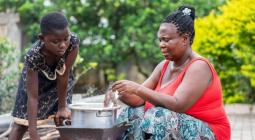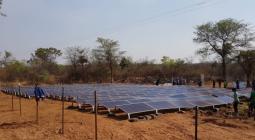As decision-makers, professionals and development finance institutions gather in Abidjan this Tuesday, March 21, 2023 in Abidjan, Ivory Coast for the Energy Access Investment Forum (EAIF), AFRIK 21 takes stock of the thorny issue of financing renewable energy in Africa. The facts are clear: despite billions of dollars released in recent years, 600 million Africans still do not have access to electricity. At the same time, 900 million Africans still cook on wood fires, even though the continent is moving towards sustainable development.
“The economy is transformed energy”, often hammers the French financier Charles Gave, referring to the energy crisis that affects the world since the beginning of the war in Ukraine, and the series of sanctions against Russia. Africa is one of the continents most affected by this energy crisis, which is reflected in the load shedding that is currently affecting the continent’s largest economies, notably South Africa and Nigeria. This crisis is also contributing to the slowing down of the electrification process in Africa.
Currently, 600 million Africans still do not have access to electricity according to the African Development Bank (AfDB). Beyond the global context, access to electricity is hampered by several factors, including insufficient funding allocated to the continent.
Africa needs $28 billion a year
According to a BloombergNEF report released at the 27th United Nations Conference of the Parties on Climate Change (COP27) in Egypt, global renewable energy investments climbed 9% year-over-year to their highest level ever in 2021. Meanwhile, investment in Africa, which accounts for only 0.6 percent of the $434 billion invested in renewable energy worldwide, has dropped by 35 percent.
To close the current gap and accelerate Africa’s electrification, the International Energy Agency (IEA) estimates that $28 billion a year should be invested until 2030. This includes about $13 billion for mini-grids, $7.5 billion for grid and $6.5 billion for off-grid investments. “Current funding commitments are far from sufficient, with significant gaps in countries such as Chad, Ethiopia and Nigeria, all of which are major population growth hubs,” notes Benson Ireri, Africa Energy Access Manager at the World Resources Institute (WRI).
Barriers to access to electricity
According to Ireri, a professor at Harvard University’s T.H. Chan School of Public Health, “significant financial commitments are needed to close this gap. However, challenges remain, including political instability, macroeconomic uncertainty (due to inflation and exchange rates), policy and regulatory issues, institutional weaknesses and lack of transparency. All of these elements create a less favorable investment climate, as well as market failures and a lack of support to channel financing to where it is most needed.
Read also- MAURITIUS: MCB finances €7.5 million for the Arsenal solar power plant
In response, the World Economic Forum (WEF) calls for a systematic approach to a well-integrated financial framework to help African countries succeed in accelerating their clean energy projects and solutions. This approach would include an organizational structure, a framework for implementing the Renewable Energy Investment Facility (REIF) proposed by UK-based Deloitte, financing instruments, business models, technical assistance, sector targeting and risk management.
Setting up PPPs
In addition to financing decentralized solutions for rural electrification, some development partners advocate the establishment of public-private partnerships (PPPs), which have so far enabled the construction of most of the major renewable energy plants in Africa in recent years. This is the case of the Lake Turkana Wind Farm, the largest wind farm in East Africa with a capacity of 310 MW, built by a consortium of several investors under the Lake Turkana Wind Power (LTWP) special purpose company.
Read also- BURKINA FASO: the Nagréongo solar power plant is commissioned as a PPP
Most of the clean energy plants commissioned in Egypt in recent years have been built under PPPs. This is the case with the Benban complex, a mosaic of solar power plants with a capacity of 1,650 MWp, commissioned in 2019 and built by a myriad of investors.
The same is true for the wind farms that are currently being built in droves in the Gulf of Suez. PPPs are also on the rise in South Africa, notably through the Renewable Energy Independent Power Producer Procurement Programme (REIPPPP) launched by the South African government to attract private investment in clean energy.
Access to clean cooking
Africa also lags behind in access to clean cooking. This is a much-neglected segment, yet it is as crucial to households as electricity. According to the World Bank, 900 million people in sub-Saharan Africa lack clean and modern energy for cooking. This situation encourages deforestation and results in the loss of $35 billion a year in spending on wood, charcoal and kerosene.
However, development partners are beginning to take an interest in this essential service. This is the case of the European Union (EU), which recently committed €12.5 million under the Modern Cooking Facility for Africa (MCFA) to support the distribution of 170,000 clean and affordable stoves, benefiting at least 870,000 people in Zambia.
Jean Marie Takouleu






